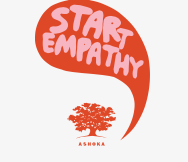Start Empathy, an initiative of Ashoka, believes that “change is accelerating in the world. To thrive as individuals and a society, everyone must be a change maker, able to take initiative to positively contribute in a world of uncertain rules, fluid institutions, and constant change. Empathy is foundational to change making. Therefore, every child must master empathy.”
Ashoka: Innovators for the Public
Click here for more information on Ashoka U Exchange, a convening of those working to promote social innovation in higher education. The Exchange was hosted by Tulane University February 25-27, 2016.
Ashoka Changemaker Schools Research
Ashoka Changemaker Schools Study
The Ashoka Empathy Project and Changemaker Schools: An Investigation of the Practices that Support the Development of Social and Emotional Intelligence in Elementary Schools (Draft, 2/27/16)
The Tulane Teacher Preparation Certification Program is partnering with Ashoka, a national organization that builds networks of social innovators in an effort to solve some of the world’s most compelling social challenges, on a research project that examines the cultivation of empathy in students from designated elementary schools across the United States.
The project is headed by Carol Whelan, Paul Tudor Jones II Professor of Social Entrepreneurship and Professor of Practice, assisted by Holly Bell, Vice President for Education at the Louisiana Endowment for the Humanities, Colette Bolton and Laura White, Tulane alumni and current teachers, and Tulane undergraduate research assistant, Nicole Siegel.
Introduction:
Seventy-three (73) schools across the United States and a total of 210 worldwide have been designated by Ashoka as Change-maker schools, an honor bestowed on institutions for excellence in cultivating their students as the next generation of social innovators. This research is based on the premise that a key attribute for motivation towards social change in individuals is having empathy. In other words, social innovators are motivated to instigate changes in the world because they possess empathy for others. The research team is examining how Change-maker schools promote pro-social behaviors and the acquisition of empathy for others in their students.
Funded by a grant from the Tulane Center for Public Service, and the Tulane Social Innovation and Social Entrepreneurship Endowment fund, the research team conducted site visits at five (5) schools across the nation; in Washington DC, Vermont, Texas, and Louisiana. The research team compiled case studies of each of the schools in order to define the processes they have put in place that create nurturing school cultures. The findings will be compared in an effort to ascertain what the programs share in common, with the hope of discovering a pattern of practices that can be replicated by other schools.
Methodology
Ashoka: The methodology for this case study consists of two components: the Ashoka Changemaker School selection process and the research methodology conducted by the Tulane University team.
Ashoka’sChangemaker Schools selection process is designed to evaluate several criteria. These include:
- Belief in “Everyone a Changemaker:” This criterion evaluates whether a school recognizes each student’s potential to be an empathic leader who can work in teams to solve problems. This expectation must be embedded in the school’s curriculum, culture, and systems.
- Innovation: This criterion addresses whether the school is home to new ideas in education, or whether it is common for existing ideas in education to be combined in creative and unusual ways. It also addresses whether the school is an environment in which it is safe for teachers, students, and administrators to propose and try new ideas.
- Influence: This criterion considers whether the school is making an effort to share its best practices with other educators. Sharing can be done through a number of means, including: frequently hosting visitors, presenting at conferences, hosting conferences, and presenting a policy-making meetings.
- Team fit with Ashoka criteria: This criterion assesses whether each individual that serves on the Ashoka partnership team for the school fits the criteria that Ashoka uses to evaluate entrepreneurial individuals. Qualities that Ashoka looks for include: entrepreneurship, ethical fiber, social and emotional intelligence, and belief in oneself as an empathic leader who can work with others to solve problems.
Research Team Site Visits
One to day site visits were conducted at five (5) schools. A list of guiding questions were asked during the site visits. They are below:
Guiding Questions for the on-site interviews:
- Curriculum:
- Do you use any of the following social and emotional learning curricula? (See list here for Collaborative for Academic, Social, and Emotional Learning (CASEL) is the nation’s leading organization advancing the development of academic, social and emotional competence for all students. Our mission is to make evidence-based social and emotional learning an integral part of education from preschool through high school. Through research, practice and policy, CASEL collaborates to ensure all students become knowledgeable, responsible, caring and contributing members of society. (https://casel.squarespace.com/about/ retrieved on 11/4/13)
- How long have you been using each of these curricula?
- How many lessons do you teach each year? Do you use it school wide? Does it have a family component, and if so, how do you use it? Etc.)
- Are there any significant adaptations they made to the curriculum?
- How do you incorporate social and emotional learning and changemaking into the academic curriculum? Similarly, do you incorporate it into other topics like STEM, Arts, Sports/Physical Education?
- How did you choose your curriculum? Similarly, how did you choose which SEL topics to teach?
- Culture:
- How would you describe your school culture?
- Tell us about how you created your school culture.
- Do you have intentional structures to create and sustain school culture? I.E. A team in place with a sole purpose to focus on school culture.
- What are the core values that you want every student to live by? How are those reflected in your school culture and your work with adults in your community?
- How do you bring parents and the surrounding community into your school culture?
Systems:
- What professional development do you do for social and emotional learning? For other topics?
- How do you incorporate your values and your commitment to empathy, social and emotional learning, and changemaking into the hiring process?
- How do you assess empathy, teamwork, leadership, and other social and emotional competencies in individual students? How do you assess your school’s progress with respect to these competencies.
- How do you incorporate social and emotional learning and changemaking into your parent engagement strategies?
- How do you incorporate social and emotional learning and changemaking into your community engagement strategies?
- How do you incorporate social and emotional learning and changemaking into your school discipline policies?
- How does your school environment (physical space) reinforce empathy, changemaking, and social and emotional learning?
- How does your school leadership structure support empathy, teamwork, leadership, and problem-solving in teachers, parents, and students?
- What other systems does your school have in place that you have incorporate social and emotional learning into?
Findings
When examining these schools, the researchers found that across all five schools, there were eight common practices and themes that the schools programs covered and an overarching presence of strong communication and collaborative leadership. Excellent communication necessitates understanding the perspectives of others. Communication and empathy are inextricably linked, and school leaders must have empathy in order to effectively communicate with the stakeholders. In fact, empathy is probably the most advanced of all communication skills. Therefore, a discussion of communication in school should include the role of empathy.The practices found in the five schools include implementing whole school activities and promoting school pride, creating programs to meet the basic needs of their students (social and emotional learning), establishing sustainability in the community and classroom, developing a well-rounded curriculum for both during and after school, offering many opportunities for student leadership and recognition, creating strong parental and community partnerships, addressing real world issues within the curriculum, and fostering student and staff self-reflection and encouragement. The research team found that while the five schools cover a wide range of types, there were definite similarities among those selected for the network: empathy-based communication integrated into school-wide practices, parent engagement, staff engagement, and student engagement. The team discovered that these empathy-based schools not only valued good communication, but also made it the center of their work.
The five schools studied include a school-wide program for cultivating pro-social behaviors. These programs go beyond basic school citizenship or anti bullying curriculums. They cause students to deeply investigate what it means to be kind, and what the cumulative effects of individual actions can mean in terms of a better quality environment at their school. Each school had in place weekly routines where all students participated in meetings at the whole-school and classroom level. These meetings take different formats within schools, but promote similar pro-social ideas. Each school program is administrator driven, but is wholly embraced by the staff as evidenced by artifacts found in most, if not all of the classrooms. Charts, sayings, practices, and student work reveal teachers supporting the school vision through regular classroom routines and frequent activities.
A second theme that was evident at the schools was implementation of social and emotional strategies (SEL). The teachers and staff interviewed at school sites also expressed strong support and need for the empathy curriculums that were being implemented. These included a combination of packaged programs and site created materials. Although some standard curriculums for pro-social behaviors were used at all of the sites, none were used in their entirety or exclusively. Each site had customized a curriculum from many sources, including creating what was not readily available, but needed.
A third theme that was evident in the schools was a focus on sustainability. Programs such as the Sunship Earth, student led green projects, school gardens, and partnerships with the community demonstrated strong connections between the curriculum and the real world.
A fourth theme that emerged was a well-rounded curriculum focusing on the whole child. Incorporation of a strong technology and arts integration and rich after school programs were evident.
Strong parental and community involvement and partnerships were also evident in all of the schools visited and communication between and among groups was evident in many forms: websites, newsletters, surveys, parent focus groups, home visits, room parents, and Tuesday folder day to name a few.
A fifth theme of student school school leadership opportunities and recognition were evident in all of the five schools.
The sixth and seventh themes included strong parental and community involvement and the addressing of real world problems including bullying, but also cross cultural partnerships. The eighth and final theme that emerged was the use of student and staff self reflection and respect.
Case studies will be shared on this site as they are completed.
LA – Lusher Charter School
VT – Bridport Elementary
DC – Maury Elementary
TX-1 – Cunningham Elementary
TX-2 – Momentous Elementary
Carol S. Whelan, Ph.D.

